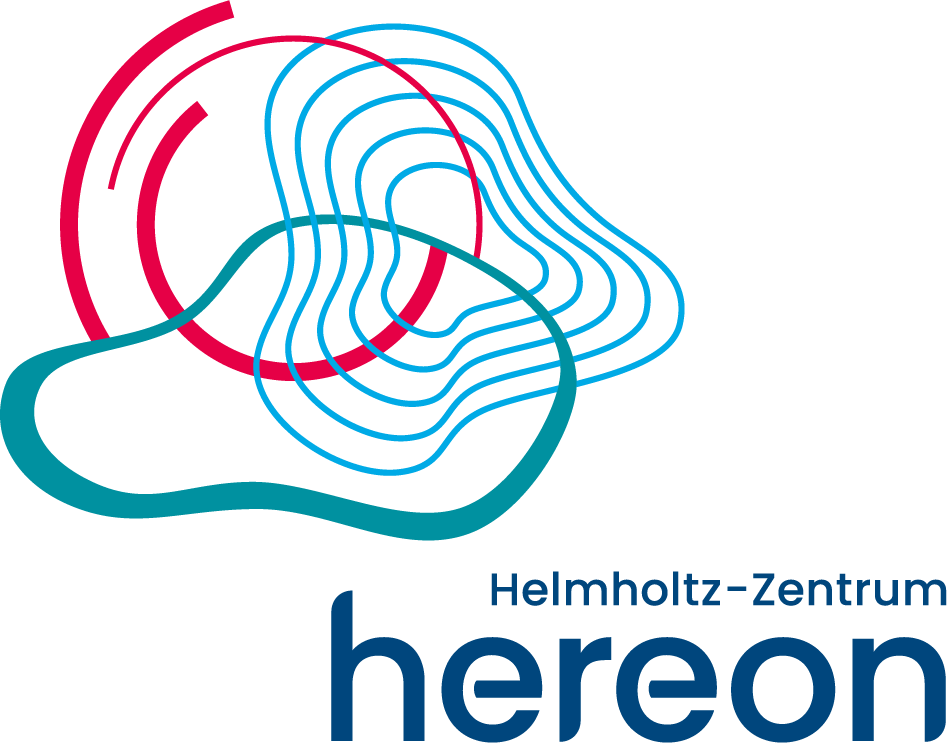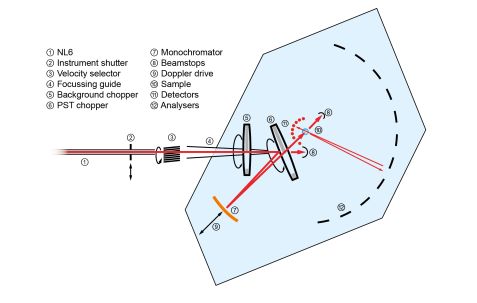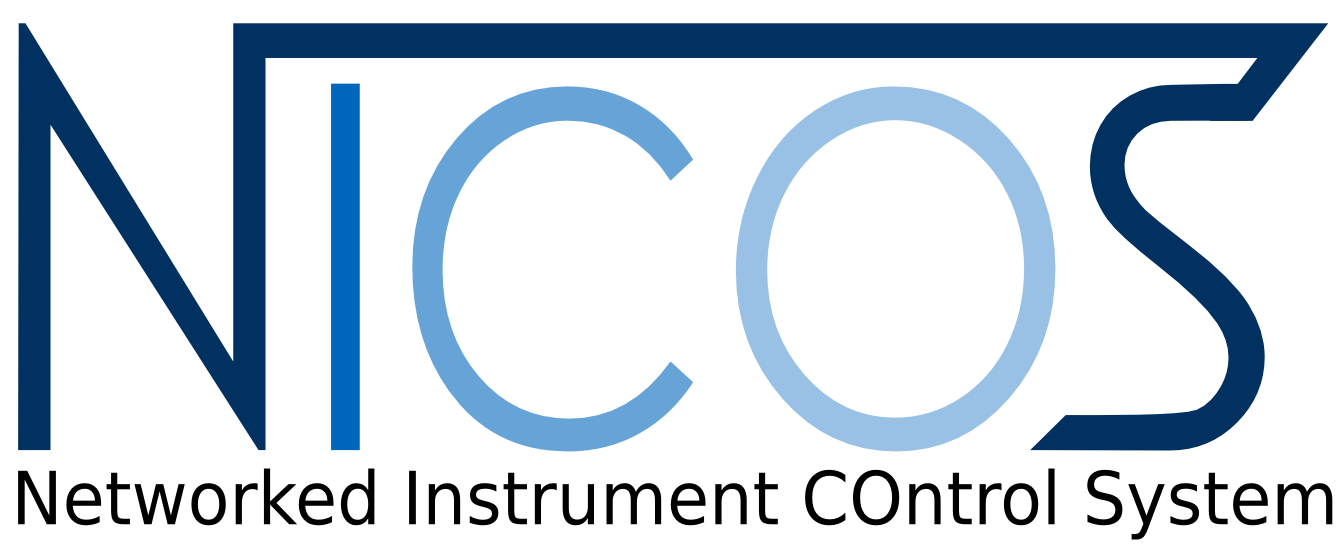MLZ is a cooperation between:
 > Technische Universität München
> Technische Universität München > Helmholtz-Zentrum Hereon
> Helmholtz-Zentrum Hereon
 > Forschungszentrum Jülich
> Forschungszentrum Jülich
MLZ is a member of:
 > LENS
> LENS > ERF-AISBL
> ERF-AISBL
MLZ on social media:

MLZ (eng)
Lichtenbergstr.1
85748 Garching
SPHERES
Backscattering spectrometer

This instrument is focussed on cold neutrons. Therefore, please carefully check the “Technical data WITHOUT cold source” section. Deviating parameters are in bold. The instrument team is happy to answer any further questions!
SPHERES (SPectrometer for High Energy RESolution) is a third-generation backscattering instrument with focussing optics and a phase-space-transform (PST) chopper [1]. It is a versatile spectrometer for investigating atomic and molecular dynamics on a GHz scale. The necessary filtering of neutron energies is achieved by Bragg reflection from perfect monochromator and analyser crystals under angles close to 180°.
The backscattering geometry makes using a primary beam deflector and a duty-cycle chopper unavoidable. At SPHERES, these two functions are realised by a chopper bearing deflector crystals on its circumference. This leads to a particularly compact spectrometer layout so that full use can be made of the focussing neutron guide. As an additional advantage, the fast motion of the deflector crystals achieves a phase-space transform of the primary spectrum, thereby enhancing the flux at the sample.
The redesign of PST chopper and focussing guide in recent years led to a more than doubled intensity. The newly installed background chopper also allows for a low background set-up with a significantly increased signal-to-noise ratio by eliminating every second pulse, albeit at the cost of intensity.
SPHERES enables investigations on a broad range of scientific topics. It is, in particular, sensitive to the incoherent scattering from hydrogen and allows access to dynamic processes up to a timescale of a few ns. Typical applications include, for example, relaxation processes in soft matter materials like polymers [2] and nanocomposites, dynamics in biological systems [3] or hydrogen diffusion in various systems like ionic conductors and fuel cells [4]. Furthermore, the high resolution of the spectrometer allows for the investigation of the dynamics of viscous liquids and water in confined geometry [5]. Other important applications are hyperfine splitting in magnetic materials [6] or reorientational motions and rotational tunnelling [7].
[1] Wuttke et al., Rev. Sci. Instrum. 83, 075109 (2012).
[2] Zorn et al., Macromolecules 53, 6731 (2020).
[3] Schirò et al., Phys. Rev. Lett. 126, 088102 (2021).
[4] Appel et al., RSC Adv., 9, 37768 (2019).
[5] Soininen et al., J. Chem. Phys. 145, 234503 (2016).
[6] Chatterji et al., J. Phys.: Condens. Matter 31, 025801 (2019).
[7] Rok et al., CrystEngComm 22, 6811 (2020).
- Hyperfine splitting
- Molecular reorientations and rotational tunnelling
- Dynamic signature of phase transitions
- Hydrogen diffusion
- Liquid dynamics
- Polymer relaxation
- Protein motion
- Cryofurnace: 3 – 700 K
- Dilution inset: 100 mK
- Furnace: up to 1700 K
- Neutron guide: NL6-S
- Neutron wavelength: 6.27 Å
- Neutron energy: 2.08 meV
- Illuminated area: 40 × 30 mm2
- Q-range: 0.2 – 1.8 Å-1
- Resolution FWHM: 0.62 – 0.66 µeV
- Dynamic range: ±31 µeV
As the flux at 6.27 Å without the cold source is expected to be low, the focus will be on fixed window scans.
- PST chopper frequency: 83 Hz
- Background chopper frequency
- 83 Hz: high-intensity setting
- 41.5 Hz: high signal-to-noise setting
- 10 3He counter tubes
- 4 small angle 3He front-window counters (out of backscattering)
- 6 position-sensitive diffraction detector tubes (covering scattering angles of about 30° to 120°)
- Neutron guide: NL6-S
- Neutron wavelength: 6.27 Å
- Neutron energy: 2.08 meV
- Iluminated area: 40 × 30 mm2
- Q-range: 0.2 – 1.8 Å-1
- Resolution FWHM: 0.62 – 0.66 µeV
- Dynamic range: ±31 µeV
- PST chopper frequency: 83 Hz
- Background chopper frequency
- 83 Hz: high-intensity setting
- 41.5 Hz: high signal-to-noise setting
- 10 3He counter tubes
- 4 small angle 3He front-window counters (out of backscattering)
- 6 position-sensitive diffraction detector tubes (covering scattering angles of about 30° to 120°)
Raw histograms are accumulated on an equidistant ω grid. A script driven programme, SLAW [1], is provided to normalise the raw counts, to perform optional binning, and to deliver S(q,ω) in a variety of output formats so that users are not bound to any specific data analysis programme. In data fitting, it is critically important to convolute theoretical models with the measured resolution function in an efficient and numerically stable way. We strive to support best practice through our FRIDA package [2].
[1] Wuttke, J.: SLAW – a neutron histogram to scattering law converter, https://jugit.fz-juelich.de/mlz/spheres/slaw
[2] Wuttke, J.: FRIDA – fast reliable interactive data analysis, https://jugit.fz-juelich.de/mlz/frida
Instrument scientist
Dr. Michaela Zamponi
Phone: +49 (0)89 158860-793
E-mail: m.zamponi@fz-juelich.de
SPHERES
Phone: +49 (0)89 158860-522
Operated by

Funding

Publications
Find the latest publications regarding SPHERES in our publication database iMPULSE:
Citation templates for users
In all publications based on experiments on this instrument, you must provide some acknowledgements. To make your work easier, we have prepared all the necessary templates for you on this page.
Instrument control
Gallery

MLZ is a cooperation between:
 > Technische Universität München
> Technische Universität München > Helmholtz-Zentrum Hereon
> Helmholtz-Zentrum Hereon
 > Forschungszentrum Jülich
> Forschungszentrum Jülich
MLZ is a member of:
 > LENS
> LENS > ERF-AISBL
> ERF-AISBL
MLZ on social media:





